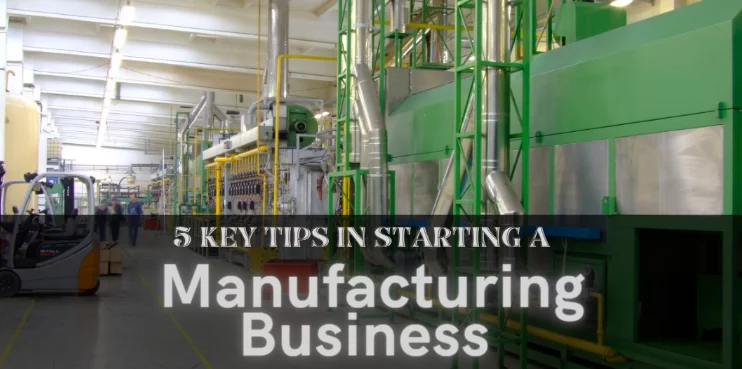
If you want to start a manufacturing business, you’re not alone. The manufacturing industry is one of the most profitable and fastest-growing sectors in the economy. If you’re looking for a way to make money without having to deal with the headache of customer service and marketing, this is the perfect business for you.
What is a manufacturing business?
Before we dive into how to start a manufacturing business, let’s take a look at what it means exactly. A manufacturing business makes products from raw materials using machines and other production equipment like some types of conveyor belt material. These businesses are often called “vertical manufacturers” because they produce something from start to finish, rather than just assembling parts that have been produced elsewhere.
Manufacturers usually work with their own materials and use their own machinery, but some choose to outsource parts of their process instead of buying everything outright. You can also find manufacturers who specialize in making only certain kinds of parts or components — these are called “job shops” or “suppliers.”
Manufacturers fall into two categories: OEM (original equipment manufacturer) and ODM (original design manufacturer).
The difference between OEM and ODM is the number of steps in the manufacturing process. OEMs make parts for other companies, while ODMs design products and then make them themselves.
OEMs might buy components from other suppliers, but they don’t manufacture their own products. They can also be known as “turnkey” companies because they offer a complete service to their customers — from design to production.
For example, if you buy a computer from Dell, it is an OEM. If you buy a Dell monitor, it is also an OEM product.
ODMs usually have their own factories, so they can control the whole process from design to manufacture. They’re also responsible for quality assurance and after-sales support.
The main advantage of being an ODM is that you get full control over the design of your product. You can create exactly what you want, without having to compromise on anything. This gives you a competitive advantage over other brands because you can offer a unique product or service that no one else does — at least not as well as you can!
The process of outsourcing your manufacturing requirements can be complex and requires careful consideration. Here are some tips to help you choose between OEMs and ODMs:
- Choose an ODM if you need flexibility and customization options
- Choose an OEM if you want consistency and quality control
- Consider whether you want to manage the entire production process or just oversee it
How to start a manufacturing business
Starting a manufacturing business is a great way to create your own job, work for yourself and earn a living. But where do you start?
If you have an idea for a product and want to move forward with it, there are a few things you need to consider before making the leap into manufacturing. Here are easy steps to get your manufacturing business started:
1. Find the right location
The first step in starting a manufacturing business is finding the right location. This is where you’ll be spending your time, so you want to make sure it’s a good fit for your business.
Factors to consider when choosing a location for your manufacturing business
The best locations for manufacturing businesses are those with easy access to transportation and customers. If you plan on selling directly to customers, choose a location that’s convenient for them. If you sell to retailers or distributors, choose a centrally located spot that will make it easy for them to pick up orders and drop off shipments.
In addition to location, consider:
- Accessibility. If your business is going to have trucks delivering or picking up goods, make sure there’s plenty of space for them to maneuver. You may also want to consider access to public transportation if that’s important for your employees.
- Cost of rent or mortgage payments including utilities (water, gas, and electricity).
- The cost of labor including wages, benefits, and taxes—may vary by state or county.
- Property tax rates which may include property tax exemptions based on job creation or capital investment in equipment.
2. Choose your products or services
Before you start your manufacturing business, you need to decide what products or services you’ll offer. This will help you determine what type of business entity you need to create and whether it makes sense for you to outsource certain aspects of your business.
Here are some things to consider when choosing your products or services:
Do you have a passion for the product? If not, it’s going to be hard for you to sell it. Having a passion for what you’re doing will help keep your energy up when things get tough.
Will others buy this product? Is it something that people need and want? Does it solve a problem that people have? If the answer is no, it might be time to look at other products or services.
Can I make money selling this product? Will I be able to generate enough profit from each sale so that my business can continue growing without me having to increase prices too much? If not, then maybe this isn’t the right product or service for your business after all.
What other factors do I need to consider before choosing my products or services? You might also want to think about how much time and effort each product takes per unit sold.

3. Invest in technology and equipment
In the manufacturing industry, it’s important to invest in technology and equipment that can help increase your production levels. This includes everything from various types of conveyor belt material to automated systems and machinery.
If your company is still small, you may not have the resources or need for automated manufacturing equipment like conveyors or robotic arms. But as your business grows, it makes sense to invest in technology that can help your operation run more smoothly.
For example, if you’re running a food manufacturing business and want to expand your production capabilities, consider investing in a conveyor system for transporting products from one station to another. This type of technology can help improve efficiency by reducing human error and increasing productivity.
Another option is to purchase automated machinery that performs tasks such as packaging or labeling products automatically. This way there’s no need for employees to manually perform these jobs — which means less time wasted on repetitive tasks and more time spent doing other things like managing inventory or managing customer accounts.
4. Look for investors and funding sources
You can find investors in many places, including online. There are a number of online platforms that connect entrepreneurs with possible investors.
You can also look for investors at local business accelerators and incubators, trade shows and conventions, or at local events such as networking groups or seminars.
If you don’t find any investors who are willing to invest in your manufacturing business but still want to start it, consider crowdfunding sites such as Kickstarter and Indiegogo. These sites allow you to post an idea for a product or company and ask people to donate money toward making it happen. Whether the donations reach their goal or not, donors receive perks from the entrepreneur depending on how much they donate.
Next up are banks and venture capitalists. Banks generally won’t give loans unless you already have some sort of collateral—such as property or equipment—that can be repossessed if you don’t repay the loan on time or at all. Venture capitalists usually invest only in high-risk ventures with a lot of potential payoff down the road; manufacturing businesses tend not to fall into this category because there are so many variables involved—such as labor costs and raw materials prices—that make predicting profits difficult.
5. Reach out to businesses
There are over a million manufacturing firms in the U.S. alone, so you have plenty of competition when it comes to getting your product in front of business owners who are looking for what you have to offer.
The best way to get started is to reach out directly to companies that might buy your product. This could be local businesses or even large corporations like Walmart or Target. Ask if they’d be interested in buying your products at wholesale prices or if they would let you sell them in their stores. If so, how much would they be willing to pay?
Here are some ways to find businesses looking for your product:
Online: Use social media or through email, and offer up a free sample of your product.
Cold calling: Cold calling is an old-school way of getting new clients, but it still works today. Call up local stores and ask if they need any products made. Most stores won’t buy directly from you — they want to go through distributors or other resellers — but they might be able to refer you to someone who can help them purchase your product on their behalf. If nothing else, cold calling will give you valuable feedback about how popular your idea is and what obstacles there may be in selling it (e.g., pricing).
Trade shows: Trade shows are another great place to meet potential buyers face-to-face and show them what you’re offering. Look for industry events that cater specifically to the type of buyers you’re targeting, such as home improvement shows for DIYers or electronics conventions for tech startups).
Takeaway
The process of starting a manufacturing business is one that may seem intimidating at first. With so much to do, budgets to prepare for, and specialized knowledge needed to run the organization, it’s not surprising that many prospective entrepreneurs are hesitant to get started.
Well, there is good news: it is possible to start a manufacturing business without an extensive technical background or an overhead cost that will require massive financial backing. Of course, it still helps if you have a team of experts to help with things like obtaining financing and managing your cash flow. But you can start your own manufacturing business on your own time and on your own terms!
And all it takes is just a little bit of information and the right advice from experts who have been where you are now.


